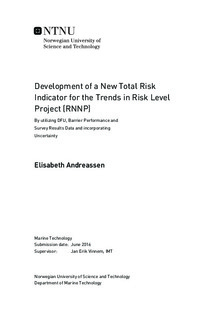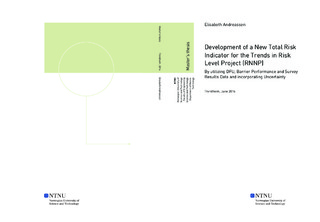| dc.description.abstract | The Trends in Risk Level Project (RNNP) is conducted annually by the Norwegian Petroleum Safety Authority (PSA). The purpose of RNNP is to objectively present offshore risk levels and risk trends on the Norwegian continental shelf (NCS). Major accidents and even near-misses have been few or non-existent in the time period RNNP has been conducted, and the decline in incident reports has reduced the data basis for quantitative risk assessment (QRA) considerably. RNNP presents risk levels and risk trends by establishing a total indicator which is established by evaluating major accident precursor event (DFUs) statistics. The objective of this thesis has been to develop a New Total Indicator which is able to give a more holistic risk level and risk trend presentation than the current total indicator. After developing a New Total Indicator, a case study was executed to test the quality and applicability of the methodology.
The development of the New Total Indicator is based on current and newly developed methodology, utilizing existing and newly established RNNP data. The concept behind the New Total Indicator is to represent a broader risk image than its predecessor. The New Total Indicator addresses uncertainty and survey results in addition to the traditional DFU and barrier performance data, which are already a part of the RNNP risk level presentation.
The New Total Indicator consists of the contribution of four individual indicators; I) DFU Indicator II) Barrier Indicator III) Survey results Indicator IV) Uncertainty Indicator. I-III are individually established, expressed as relative values. IV is a corrective factor, individually established and incorporated in indicators I-III. The New Total Indicator is presented as two relative indicators; leading (The Barrier Indicator and Survey Results Indicator) and lagging (The DFU Indicator), where the relative uncertainty contributions are incorporated in both indicators.
The case study established New Total Indicator Results for years 2008-2014 by evaluating RNNP data from fixed production installations only.
The results are considered satisfactory from a case study perspective, indicating a positive (decreasing) risk level trend for the leading indicator in the chosen time period. The lagging indicator shows a variable trend with a negative (increase) trend in risk levels from 2012-2014. Compared with published total indicator results; the New Total Indicator results differ considerably. This is due to their differences in structure and design, but also due to a different data basis for establishing results. The case study demonstrates the ability of the developed New Total Indicator to produce satisfactory results.
The numerous data and method assumptions in this thesis question the applicability of the New Total Indicator and the quality of results. The New Total Indicator is, in its present state, not considered recommendable for implementation in RNNP. The results are satisfactory from a case study perspective, but the methodology itself needs to be developed further to reduce method uncertainty and improve the method quality.
Despite the method shortcomings, it is recommended to evaluate whether the developed DFU Indicator could replace the current total indicator in RNNP. The DFU Indicator is similarly established as the current total indicator, but includes DFU 12 (helicopter incidents). In light of the tragic helicopter accident at Turøy in April this year, the suggested DFU 12 weights may be a solution for incorporating helicopter risk in the RNNP total indicator.
The developed New Total Indicator methodology is an exciting contribution to the discussion on the role of overall vs. individual indicators in risk level presentation. In conclusion this thesis contributes more to the discussion on the future risk level presentation of RNNP, rather than producing a methodology ready for embodiment in RNNP. | |

